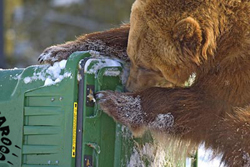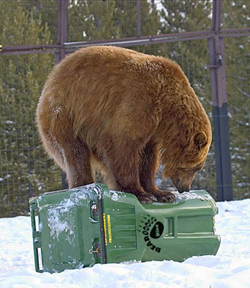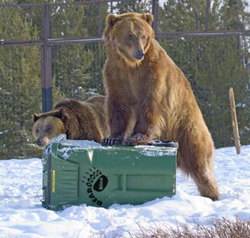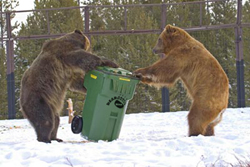| Facts About Bears To Keep Your Home Safe |

Click here to order



 BEARicuda Bins? have passed the
test - the bears will try but they won't get in.
BEARicuda Bins? have passed the
test - the bears will try but they won't get in.

Questions & Answers
Q: What can I do to avoid an encounter with a bear?
A: Make noise! Let bears
know you\'re there. Call out, clap hands, sing or talk loudly especially
near streams, dense vegetation and berry patches, on windy days,
and in areas of low visibility. (Some research shows that bear
bells are not enough).
Watch for fresh bear sign. Tracks, droppings,
diggings, torn-up logs, turned-over rocks are all signs that a
bear has been in the area. Leave the area if the signs are fresh.
Keep your dog on a leash at all times or leave
it at home. Dogs can provoke defensive behavior in bears.
Travel in groups if possible and never let children
wander.
Use officially marked paths and trails and travel during
daylight hours.
If you come across large dead animals, leave the area immediately
and report it to Park Wardens.
Dispose of fish offal in fast moving streams or the deep part
of a lake, never along stream sides or lake shores.
Q: What should I do if I encounter a bear?
A: Stay calm and don't
alarm the bear with screams or sudden movements. Your calm behavior
can reassure it. Bears may bluff their way out of an encounter
by charging and then turning away at the last second. Bears may
also react defensively by woofing, growling, snapping their jaws,
and laying their ears back. It\'s difficult but important to REMAIN
CALM if a bear reacts to you this way. A scream or sudden movement
may trigger an attack.
Speak to the bear. Let the bear hear your voice
- talk calmly and firmly. This lets the bear know you are human
and not a prey animal. If a bear rears on its hind legs and waves
its nose about, it is trying to identify you.
Back away slowly, never run! Running may trigger
a pursuit and bears can run as fast as a racehorse, both uphill
and downhill.
Make yourself less vulnerable pick up small children
and stay in a group.
Don't drop your pack. It can provide protection.
Always leave the bear an escape route.
|
|
Why Choose BEARicuda Bins?
Bear Proof Containers?
Bears that obtain unnatural foods are often relocated or destroyed. Food
conditioned bears also pose a safety concern for residents and can cause
costly property damage. Bear Proof Trash Cans help minimize these problems.
Here?s how you can help prevent conflicts,
and keep bears out of trouble:
Watching bears conditions them to being near people! Don?t allow
the bear to stay near your home, or within sight of humans. If possible,
safely make the bear leave by yelling and banging a wooden spoon on a
metal pan from a safe location and keep it up until the bear leaves. If
the bear is unafraid and doesn?t leave, or if you know that it has
obtained a food reward, please notify appropriate wildlife authorities.
Also using a Bear Proof Container will frustrate the animal once they
realize they cannot get into the Bear Proof Trash Can.
Early reporting is critical! The sooner a bear is conditioned
to avoid people and human development and return to wild behaviors, the
better for the bear. The longer a bear has contact with humans, the more
likely it will be successful in finding unsecured food. Call your local
Wildlife Officer or Game Warden to report bear activity early, before
bears become food conditioned or habituated to developed areas. Otherwise,
the bear may have to be destroyed!
What Attracts Bears Around Your Home
Barbeque grills should be cleaned by burning off residue and stored after
each use in a secure shed or garage away from windows and doors.
Fruits and vegetables should be picked when ripe, and
fallen fruit from trees immediately collected and disposed of in a Bear
Proof Trash Can. Do not allow fruit to rot on the ground. Do not apply
blood meal to gardens!
Bird feeders attract bears. Eliminate them or hang them
at least 10 feet high, and 4 feet away from the nearest trees. Immediately
clean up spills on the ground and place them into a Bear Resistant Container.
Hummingbird feeders can be replaced with flower baskets, which are also
attractive to hummingbirds, but not bears.
Pet food should be stored indoors, (or in a certified
bear proof garbage can) and pets fed indoors. If your pet must be fed
outdoors, feed only as much as your pet will eat in one meal. Uneaten
pet food and bones with meat on them will attract bears.
Livestock feed should also be stored in a secure shed
or barn or bear container resistant garbage can container. Uneaten feed
should immediately be removed.
Garbage should be stored in bear proof trash can, or
indoors in a secure shed or garage. Place all garbage in tightly sealed
plastic bags to reduce odors, and remove garbage regularly. Cleaning bear
proof garbage containers periodically with a diluted Clorox solution will
also help reduce odors, which attract bears. Do not put garbage out until
the morning of collection
Compost piles should be limited to grass, leaves, and
garden clippings. Adding lime and turning regularly will help reduce odors,
and help composition. Do not add food scraps! Kitchen scraps can be composted
indoors in a worm box with minimum odor and later added to garden soil.
Beehives, honey, and bee larvae are especially attractive
to bears. If you keep hives, elevate them on bear-proof platforms, or
erect properly designed electric fencing.
You can help grizzly and black bears by sharing this information with
your friends and neighbors. The more people participate in removing attractants
and helping bears stay wild, the more likely it is that bears and people
can safely coexist. When a whole neighborhood works together to remove
the things that attract bears, the conflicts between humans and bears
in that area is reduced dramatically!
Bear Safety At Home -
What to do if you
see a bear near your home.
Remain Calm
Often the bear is just passing through, and if it finds no food source,
will simply move on.
Keep Well Away
Never approach a bear. Do not crowd the bear ? give it plenty of
space and a safe avenue of escape. Warn others to keep away, bring your
small children and pets in the house, if necessary.
Never feed a bear ? either intentionally or unintentionally
Keep all garbage in a bear proof garbage can or indoors until it can be
properly disposed of. Remove all backyard attractants i.e. bird feeders,
fallen fruit, pet food, dirty barbecue?s, and odorous compost.
Let the bear know it is not welcome in your backyard
Do not allow the bear to feel comfortable in 'your' territory, not even
for a photo opportunity. Assess the situation and ensure the bear has
a clear and safe avenue of escape. Show the bear your human presence from
a secure position (e.g. balcony or window). Stand facing the bear; making
yourself look as big as possible. Use a firm tone of voice to make it
feel uncomfortable and encourage it to leave. You can also try banging
together pots and pans or throwing stones. After the bear has left the
area, remove any food sources that might have attracted it and place food
in a Bear Proof Garbage Can. Deterrents are also available to help discourage
bears from entering your property.
When to call for help
If the bear appears to be threatening human safety or pets or livestock;
or destroying property, call the Police or the Conservation Officer Service
elsewhere. Ask them to use non-lethal alternatives!
Encountering a bear
If you do see a bear at a distance, enjoy watching it, and either back
off or wait for it to leave. Do not approach it. Bears
have a strong sense of personal space - a distance that varies from bear
to bear from which they won't back down. If you end up inside that defensive
perimeter, which may be anywhere from ten to fifty feet wide, you are
likely to experience a combination of highly intimidating behaviors, including
the squared-off lip or long face, jaw popping, huffing, swatting and false-charging.
Some experts regard these behaviors as fear or stress-related. This
may be defensive or motivational display separate from the bear's mood,
which may be fearful or stressed. Or it may not be. One expert suggests
that you should observe the bear's mood before it squares off its lip.
That's the true mood of the animal you are dealing with. Everything that
follows the squared-off lip is defensive or motivational display.
|
You can't judge the nature of an individual encounter between a bear
and a human on the basis of whether the bear is displaying one behavior
or another, for a bear may use the same displays at different intensities
in different contexts.
Having fixed interpretations of any individual bear behavior can be
dangerous, not only to a person encountering a bear but also to the bear
itself. It's the escalation of fear that leads to bad decisions. There
have been a number of bear attacks that could have been avoided if the
situation hadn't been misread. Some victims have dropped to the ground
into protective positions because they thought the bear was about to
attack. That, unfortunately, is a self-fulfilling prophecy; they were
attacked. Bears, like dogs and many other animals, will enforce their
dominance when an adversary displays weakness. A bear, particularly a
dominant bear, may just test your resolve.
Black bears take eye-contact very seriously as a position of
strength. If your eyes are on the bear, they'll usually avert their
stare. If their eyes hold on you, it's a sign they intend to motivate
you. If they then walk toward you, you better leave!
So what do you do if somehow you get too close to a bear? According
to Kilham, a bear expert, stop moving and use your eyes. Keep them directly
on the bear. Use them to study the bear so you can determine its attitude
toward you. By keeping your eyes glued to it, you'll also be letting
the bear know that you're not trying to motivate it. If you feel compelled
to back up, do it when the bear is relaxed, and keep your eyes on the
bear. But chances are the bear will move away first.
It can be difficult and confusing to have a laundry list of preconditioned
responses to certain bear behaviors, read as much as possible about these
fascinating creatures. Look for them in their woods, and try to keep
them out of your backyard.
If you are lucky enough to see a bear at close range, try to keep this
simple message in your head: Hold your ground, stay calm, maintain
eye contact, and let the situation resolve itself. Your experience
will be extremely intimidating and exhilarating, but what you\'ll get
in exchange will be the adrenaline rush of a lifetime. If you need any
help in selecting the right Bear Container Proof System or Garbage Can
please call 1-877-BEARICUDA (232-7428). |














